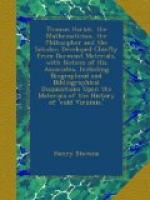poffit. De quâ quidem accefforiâ operis huius vtilitate rerum
Mathematicarum ftudiofos paucis his præmonuiffe operæprecium
efle duximus.’ [Which being interpreted reads as follows in
English]
TO STUDENTS OF MATHEMATICS.
It is not without good reason that, of all Thomas Harriot’s Mathematical writings, this on Analysis has been published first. For whereas all his remaining works, remarkable for their manifold novelties of discovery, are written precisely in the same, hitherto unusual, logical style as this treatise (which consists entirely of varied specimens of beautiful reasoning); this was certainly done that this preliminary treatise, besides its own inestimable utility, might suitably serve as a necessary preparation or introduction to the study of Harriot’s remaining works, the publication of which is now under serious consideration. Of this accessory use of this treatise we have thought it worth while to remind mathematical students in these brief remarks.
From this it appears that Hariot’s system of Analytics or Algebra was based on that of his friend and correspondent Francois Vieta, as Vieta’s was avowedly based on that of the ancients. There appears to have been no attempt whatever on the part of the Englishman to appropriate the honors of the Frenchman, as many foreign writers have charged. Full credit was given by Hariot and his friends to the distinguished French mathematician.
But Hariot’s modifications, improvements, and simplifications were so distinct and marked that from the first, and long before publication, they were called among his students and correspondents ’ Hariot’s Method,’ meaning thereby only Hariot’s peculiarities, without reference to the great merits of Vieta’s restoration, modification, adaptation, and improvement of the old analyses from the times of the Greeks.
Vieta’s’ Canon Mathematicus’ was published at Paris in 1579, and was reissued in London with a new title in 1589 as his ’ Opera Mathematica.’ But this work does not contain the Algebra. That was first published in 1591 under the following title :
’Francisci Vietæ/InArtem Analyticam/Isagoge/Seorfim excuffa ab Opere reftitutæ Mathematicæ/Analyfeos, seu, Algebraicâ nouâ. / Tvronis,/ Apud Iametivm Mettayer Typographium Regium. / Anno 1591.’ / folio. A Supplement appeared in 1593. Seven years later there came out under the auspices of Ghetaldi, a young Italian nobleman of mathematical tastes, who had been studying in Paris, the following :-’ De Nvmerosa Potestatvm / Ad Exegefum / Resolvtione. / Ex Opere reftitutæ Mathematicæ Analyfeos, / feu, Algebrà nouà / Francisci Vietæ. / Parisiis, / Excudebat David le Clerc. / 1600.’ / folio. On the last page of this book is an interesting letter from Marino Ghetaldi to his preceptor Michele Coignetto, dated at Paris the I5th of February 1600.




